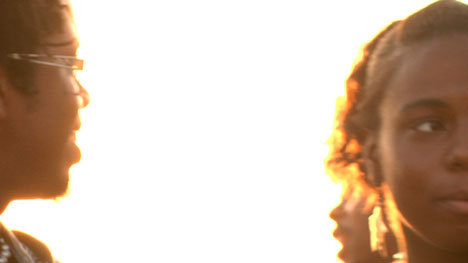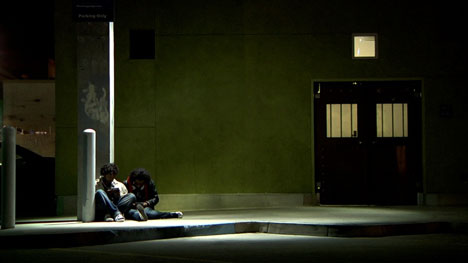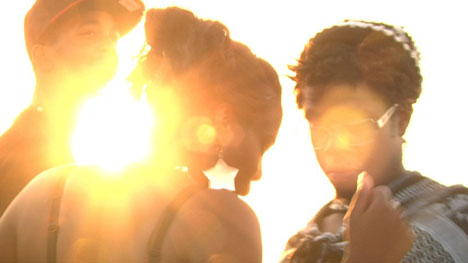Finding Light in the Dark: Goro Toshima's Broken Doors
By KJ Relth
Director and cinematographer Goro Toshima doesn't set out to find individuals on the margins of society. He's drawn to telling the stories of those whom he connects with personally. This tendency is highlighted in the way he began his most recent documentary short, Broken Doors: after reading an article in LA Weekly about a homeless youth named Rico, Toshima set out to find him with no plans or intentions other than speaking with him. Thankfully, he did plan enough to bring his camera.
What followed this initial meeting was six months of trust between subject and filmmaker as Rico allowed Toshima to document the daily struggles he and his girlfriend Starr face living on the streets of Hollywood. At times so intimate we forget the filmmaker was ever present, Broken Doors is a poignant record of the lives of two young adults wrestling with their grim reality.
This multi-award-winning short subject is currently in the running for Best Short at the 2011 IDA Documentary Awards. In light of this recent nomination, we sat down with writer, director and cinematographer Goro Toshima to discuss his background, his inspirations, and why 15 minutes is all it takes.
IDA: How did you get started in documentary
filmmaking?
Goro Toshima: In high school and college I was taking a lot of pictures and doing a lot of
photography. After college I kind of fell into this job working for this
production company that was doing short pieces for Japanese TV. They would call
the production company or we would pitch ideas to the network about some New
York story and then we would make a two- to three-minute news piece. But that
was news; it wasn't really documentary.
I was always interested in documentaries, and around that time I was thinking
of starting to get into documentary work. I ended up applying to a graduate program
for documentary filmmaking, which I got into. I graduated from Stanford, [which] has a small documentary
program. After I finished that degree I started freelancing in the Bay Area,
where there are tons of independent documentary filmmakers. So I started
freelancing, doing kind of bullshit work filing or paginating transcripts. For
me it was kind of frustrating because it never really led to anything. I was bouncing
from one office PA job to another office PA job.
I think I was doing that for five years, and then I decided that I
really wanted to make my own films. I started shooting A Hard Straight on my own. Eventually I got ITVS funding for A Hard Straight and was able to not work
for other people and just focus on that project for a couple years.

IDA: How did you meet Rico
and Starr?
GT: I saw this article in which Rico was mentioned. I tracked him down and met with
him, talked with him and started filming with him.
IDA: And you met Starr that way too?
GT: Yeah, through Rico.
IDA: What was it that made their story one you
had to tell?
GT: I think it was a combination of a lot of things. When I first met them, I
didn't know them that well. I just met them for 15 minutes and said, "Let's
start filming." I'd been in LA for
a few years, and driving up and down Hollywood [Blvd.] I saw all the street
kids. I wanted to do something local; something about street kids would be an
interesting film.
With Rico and Starr in particular, the main thing was that they were a couple.
At the time they were very close. They really depended on each other, and I
thought that dynamic was interesting. They're in love, they're a couple, and
they're on the streets. Their situation was interesting--them talking about the
turbulence in their life and how unpredictable it was, and the struggles that they
have to go through every day of being homeless. I thought all that would make
for an interesting film.
IDA: So you only knew them for 15 minutes
before you started shooting?
GT: Yeah. It wasn't the smartest idea!
IDA: But it doesn't seem like the camera is in
the way at all. You seem to be there for their most interesting moments. How
did you enter into their lives in such close quarters without the camera
getting in the way?
GT: When we were filming, we did spend a lot of time together. It was also just kind
of getting them comfortable. First of all, they felt comfortable with me as a
person. Even without the camera, just hanging out, they felt comfortable with
me. I think one of the things was that they don't have a lot of adult figures
in their lives. With me, I think they felt that they could trust me. I was this
adult figure who they could confide in and talk to about stuff. I think that
was a relationship that was important to them, so they felt comfortable.

IDA: What were some
challenges you encountered when making this film? I imagine it was hard to not
become emotionally involved.
GT: I would never do a project like this again. After a couple months it just got
so difficult watching them go through what they went through. The most
difficult was filming with them and then leaving them after filming and coming
home to my house, which is not a great house, but compared to what they live in,
it's pretty luxurious. Seeing what they went through was obviously difficult
and frustrating.
Your impulse is, you want to help them. In a lot of ways I did try to help them with
suggestions and to just try to steer them in the right direction. Ultimately,
especially for something like our relationship, there is only so much you could
do for them.
Both of them had just horrible childhoods. They have really deep, deep issues
that they need help with. As a documentary filmmaker, I'm not able or equipped
to help them in the ways they need to be helped. I think that was the most
frustrating part--wanting to help but knowing that you can't do what needs to get
done.
IDA: Your previous film, A Hard Straight, deals with other characters that are similarly on
the edge of society. Do you find that you gravitate toward telling the stories?
GT: It's not like it's a particular interest of mine. It just
happened that I made A Hard Straight.
I didn't stumble upon Broken Doors,
but it wasn't an intentional thing. It's not a theme I'm trying to pursue. The
thing that does interest me is that for both those films was these people who
have serious challenges in their lives. I think in terms of doc filmmaking and
telling stories in the documentary format, those [challenges] are thematically
an interesting subject. I wouldn't say it's a theme of the films I'm interested
in making. It just happened to be the two films that I happened to make.
IDA: The skateboarding
scene in the parking garage was very cinematic and almost meditative. Can you
tell me how that scene came to be?
GT: Basically I was just hanging out with Rico one day, and he was like, "Me and my
friends are going to go skateboarding. Let's go film it." I sort of hopped on a
skateboard. I know how to skateboard and surf so it was easy for me to shoot
it.
At the time I was thinking that I had so much footage of bad shit happening in
their lives that was sort of depressing. At the time I was really hoping for
more light themes. For instance, there's that scene where they're dancing at
Venice Beach. I wanted to do more scenes like that where it showed the fun side
of their lives. When we did the skateboarding scene, I was really happy because
I thought that was how I would use that particular footage, [as] something that
showed something a little lighter in their lives.

IDA: How much time did you spend shooting the
film?
GT: I would say over the course of six months or so.
IDA: How many hours of footage did you end up
with?
GT: That's kind of difficult to answer because I was shooting on P2 [cards]. These
days, you measure in gigabytes instead of hours. I had something like two terabytes
or a terabyte and a half. If I were to guess, I would say maybe 50 or 60 hours.
A typical documentary has about 100 to 200 hours, but this was a short.
IDA: Did you set out with the intention of
making a short?
GT: No, I actually set out with the intension of making the feature. As I was
shooting and shooting and tracking the story, [I was] thinking in my head what
the story was going to be as I was filming. The thing is, not a lot happens
in their lives. There are moments that are super unpredictable and dramatic,
like they lose their place, or Starr gets pregnant, or Starr gets the
abortion. But I'd say in general, their lives are kind of static. There's not
much movement in their lives. The same thing was happening over and over. Rico
and Starr lost their place when I was filming with them two or three times, and
Starr actually got pregnant a couple of times. It was sort of the same thing
repeating itself. I cut a feature-length version and started getting feedback.
Everyone was saying it was cyclical and too repetitive. At one point I just
decided to contain it into a short.
IDA: Who are other filmmakers that inform your work or inspire you?
GT: I'd say the people who inform or inspire my work the most are my friends who
work in documentary. There's this guy Mark Becker, who's a good friend of mine.
He helped me a lot with this film. This guy named Daniel Baer, another independent
documentary filmmaker; a friend of mine, Tim Roberts, who's an editor. Those
were the people who I went to Stanford with who were the closest to me in terms
of filmmaking and who inspire me the most.
IDA: What has the audience reaction been when
you screen this film? Have you been surprised by those reactions?
GT: It's a little bit hard to gauge because it's gotten into festivals, and I've
gone to festivals but there haven't been big audiences as the screenings I've
been to. I get the basic questions of how I found them and how they're doing,
and what it was like filming with them. The reactions are more of curiosity
about Rico and Starr and my relationship with them. It's a little difficult to
gauge a general audience reaction because I haven't been exposed to a lot of
audience reaction yet.
